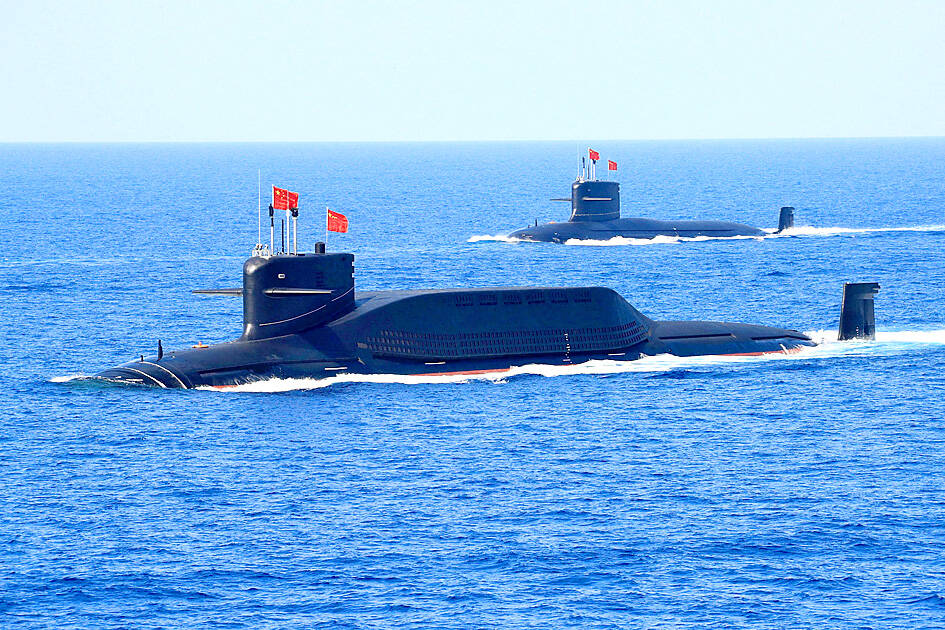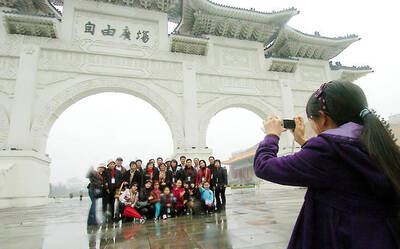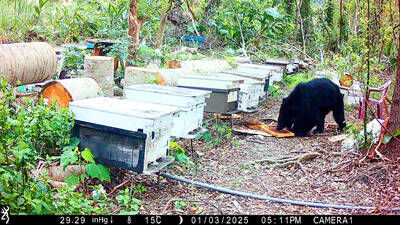China has about 70 conventional submarines on active duty as well as two new nuclear submarines that no longer carry a “turtle-back” design, an annual report published by the Institute for National Defense and Security Research said.
The capabilities of the two new nuclear submarines — the Type 095 and Type 096 — match those used by the US and Russia, the institute’s 2023 Assessment Report of the Chinese Communist Partys’ (CCP) Government and Military Development said.
The analysis of China’s People’s Liberation Army Navy (PLAN) combat capabilities conducted by retired Republic of China Navy captain Chiang Shin-biao (江炘杓) offered a different assessment from the US Department of Defense’s report on Military and Security Developments Involving the People’s Republic of China, published last year. The US report said that China has about 60 submarines, including six ballistic missile nuclear submarines, six nuclear-powered attack submarines and 48 submarines powered by diesel or air-independent propulsion (AIP), also known as hunter-killer submarines.

Photo: Reuters
However, it warned, that China would have 65 submarines in its fleet by next year, and the number could increase to 80 by 2035.
Chiang said the US report gave a relatively conservative estimate based on the existing intelligence.
“However, the Nuclear Threat initiative, a US non-profit organization, had said its data collected in 2020 showed that China had 65 to 70 submarines. Supposing that China can build two submarines per year and retire some annually, it should have about 70 submarines in its fleet. The number could reach 76 by 2030,” he said.
China’s navy uses mainly diesel-powered or AIP-powered submarines for offshore defense, such as the Type 039C submarine, which has a full load displacement of about 3,600 tonnes, a diving depth of more than 300m and a maximum submersible speed of about 22 knots (40.74kph), Chiang said.
The submarine can carry 12 torpedoes and six submarine-launched missiles, he said, adding that it could be mass-produced as it is a well-developed technology and has better silent effects and stronger strike effectiveness.
The PLAN now has one Type 095 nuclear-powered attack submarine on active duty, Chiang said. The nuclear submarine’s maximum diving depth is 500m and has a self-sustaining capability of about 90 days, he said.
It can carry 24 torpedoes and 16 vertical launch units and is equipped with YJ-18 anti-ship missiles, CJ-10 land attack cruise missiles and HQ-10 anti-aircraft missiles, he added.
Aside from having one Type 092 and six Type 094 ballistic missile nuclear submarines, the PLAN is building a Type O96 submarine, Chiang said.
The displacement of the third-generation submarine is expected to be enlarged to 15,000 tonnes, and is equipped with 24 JL-3 ballistic missiles and YJ-18 series anti-ship missiles, he said. “The new nuclear submarine not only can carry out nuclear counter attacks against the enemy, but also attack the enemy’s fleet on the sea surface from a long distance. It has a deterrent effect on an enemy’s carrier strike group and establishes favorable conditions for ‘anti-access/area denial’ military strategies,” Chiang said, adding that a sizable fleet using Type 096 submarines might be formed by 2030.
While the US Navy has said the Chinese Navy’s expanding submarine fleet has yet to pose a challenge, Chiang said the Type 094 and other models of previous ballistic missile nuclear submarines had the problem of an overly large “turtle back” configuration for submarine-launched missiles. “However, as China’s submarine-launched missile miniaturization technology improves, these two new nuclear submarines will completely rid Chinese nuclear submarines of being nicknamed ‘undersea tractors,’ and their performance will also be improved, keeping pace with the US and Russia,” he said.
Taiwan’s Admiral Huang Shu-kuang (黃曙光), who heads Taiwan’s indigenous defense submarine program, said he hopes the nation has three combat-ready submarines by next year and four by 2027.

SHIPS, TRAINS AND AUTOMOBILES: The ministry has announced changes to varied transportation industries taking effect soon, with a number of effects for passengers Beginning next month, the post office is canceling signature upon delivery and written inquiry services for international registered small packets in accordance with the new policy of the Universal Postal Union, the Ministry of Transportation and Communications said yesterday. The new policy does not apply to packets that are to be delivered to China, the ministry said. Senders of international registered small packets would receive a NT$10 rebate on postage if the packets are sent from Jan. 1 to March 31, it added. The ministry said that three other policies are also scheduled to take effect next month. International cruise ship operators

NUMBERS IMBALANCE: More than 4 million Taiwanese have visited China this year, while only about half a million Chinese have visited here Beijing has yet to respond to Taiwan’s requests for negotiation over matters related to the recovery of cross-strait tourism, the Tourism Administration said yesterday. Taiwan’s tourism authority issued the statement after Chinese-language daily the China Times reported yesterday that the government’s policy of banning group tours to China does not stop Taiwanese from visiting the country. As of October, more than 4.2 million had traveled to China this year, exceeding last year. Beijing estimated the number of Taiwanese tourists in China could reach 4.5 million this year. By contrast, only 500,000 Chinese tourists are expected in Taiwan, the report said. The report

The Forestry and Nature Conservation Agency yesterday launched a gift box to market honey “certified by a Formosan black bear” in appreciation of a beekeeper’s amicable interaction with a honey-thieving bear. Beekeeper Chih Ming-chen (池明鎮) in January inspected his bee farm in Hualien County’s Jhuosi Township (卓溪) and found that more than 20 beehives had been destroyed and many hives were eaten, with bear droppings and paw prints near the destroyed hives, the agency said. Chih returned to the farm to move the remaining beehives away that evening when he encountered a Formosan black bear only 20m away, the agency said. The bear

Chinese embassy staffers attempted to interrupt an award ceremony of an international tea competition in France when the organizer introduced Taiwan and displayed the Republic of China flag, a Taiwanese tea farmer said in an interview published today. Hsieh Chung-lin (謝忠霖), chief executive of Juxin Tea Factory from Taichung's Lishan (梨山) area, on Dec. 2 attended the Teas of the World International Contest held at the Peruvian embassy in Paris. Hsieh was awarded a special prize for his Huagang Snow Source Tea by the nonprofit Agency for the Valorization of Agricultural Products (AVPA). During the ceremony, two Chinese embassy staffers in attendance